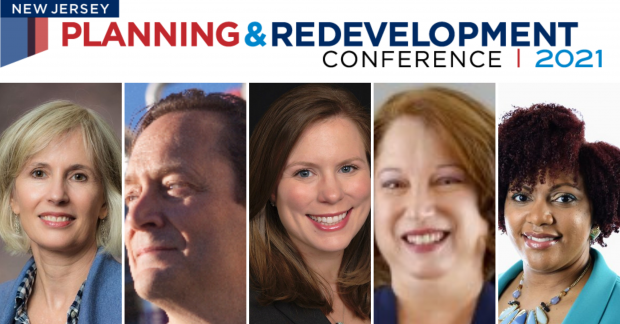New Jersey Future Blog
Water, Water Everywhere—Achilles Heel or Asset?
June 24th, 2021 by Missy Rebovich

Water is essential for life, but the infrastructure that brings it into our homes—or keeps it out of our basements—is only considered when something goes wrong. At the 2021 New Jersey Planning & Redevelopment Conference session Water, Water Everywhere—Achilles Heel or Asset? panelists discussed why water can no longer be treated as an add-on issue to which communities simply react. Moderated by Chris Sturm, managing director, policy and water at New Jersey Future, the session featured George Hawkins, founder and CEO of Moonshot Missions; Jennifer Gonzales, director of environmental services, City of Hoboken; Meishka Mitchell, vice president, Cooper’s Ferry Partnership; and Lisa J. Plevin, executive director, New Jersey Highlands Council.
One way to infuse consideration of water into planning and decision-making is by local ordinance. Hawkins explained how Washington, D.C. changed its development and redevelopment ordinance to highlight stormwater capture in response to increasing flooding during rainstorms. “This started 10 years ago and has gotten stronger over time. You must capture in a new project or a redevelopment project 1.2 inches of rainfall on site. That’s required to get your permit to do the redevelopment. But flexibility is built in, so if you can’t do it on-site, there’s a mitigation bank, like a wetland mitigation bank, but for green infrastructure.”
Developers encountering site constraints to green infrastructure can pay into the fund, which allows the District Department of Environment to construct green infrastructure elsewhere with the same criteria. The bank creates a marketplace to ensure green infrastructure is generated by all new development.
In the New Jersey Highlands, municipalities are required by state law to update their master plans in conformance with the Highlands regional master plan. “Protecting water resources in the Highlands region is critical,” said Plevin. “Because, while the region makes up less than 20% of the population of our state, it is the source of drinking water for over 70% of the state’s residents.”
Plevin noted that “clean, plentiful water is really important; however, municipalities are often focused on their own local boundaries and not on watershed boundaries.” That’s why the New Jersey Highlands Council works closely with the region’s municipalities and counties to ensure local plans are developed in ways that maximize water resource protection.
In Hoboken, an urban coastal city with a combined sewer system, local leadership is acutely aware of the importance of stormwater management. In order to leverage capital, Gonzalez explained, the City looks to multi-benefit projects. For example, Hoboken’s Washington Street Redesign project—which won a New Jersey Future Smart Growth Award in 2020—involved replacing drinking water infrastructure across 15 blocks of the city. This work allowed the City to install complete streets upgrades at the same time, installing four green/gray infrastructure projects involving porous pavement and underground detention basins in the public right-of-way.
“We employ a One Water approach where we can manage drinking water and manage stormwater all through one capital plan,” said Gonzalez.
Community organizations—and community members, themselves—play an important role in connecting water issues to city planning. Camden’s century-old combined sewer system has received lots of attention from residents experiencing frequent contaminated flooding. Mitchell explained, “In the early 2000s, Cooper’s Ferry Partnership began to think about planning and redevelopment on a neighborhood scale. It was when we started to do more neighborhood-driven community outreach that we began to really understand the impact water was having in the city and how we needed to address it.”
As much as the residents learned about water infrastructure, Mitchell says she learned more from the residents. Community members addressed local flooding as their number one issue, which helped the local government see its impact, including on a young student who expressed concern that her school bus wouldn’t be able to make it to take her to school during a rain event. “Water infrastructure, whether combined sewer flooding, lead pipes, or water quality, impacts residents far more significantly than those in government could imagine. Until we talk to those residents, we won’t get a full understanding of what that means” Mitchell said.
Cooper’s Ferry Partnership has been working with the City of Camden to incorporate green infrastructure into everything it can—from art installations, to park development, to new building development—and making sure that water infrastructure is part of the planning process, keeping residents front and center.
Panelists noted that funding can be a significant barrier to implementing green infrastructure and other water infrastructure projects. In Camden, Mitchell found that her nonprofit organization and the City, working collaboratively and creatively, can leverage each other’s resources to move critical projects forward. Hawkins shared that D.C. implemented a stormwater utility to fund stormwater infrastructure upgrades, and Hoboken is investigating how it can do the same.
Keeping water at the forefront of planning is key to the health of our communities. By working together, government leaders, utilities, community groups and members can develop and implement plans that will make our cities and towns strong and resilient for centuries to come while protecting our most valuable natural resource: water.
Related Posts
Tags: NJPRC21, Planning and Redevelopment Conference, Water, water infrastructure
















